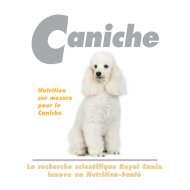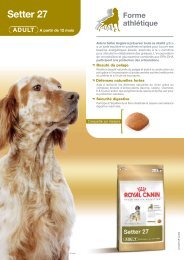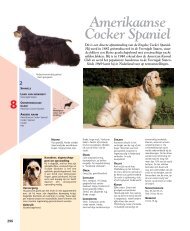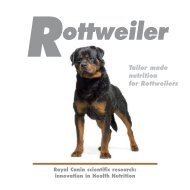The Great Dane - Breed Nutrition - Royal Canin
The Great Dane - Breed Nutrition - Royal Canin
The Great Dane - Breed Nutrition - Royal Canin
Create successful ePaper yourself
Turn your PDF publications into a flip-book with our unique Google optimized e-Paper software.
<strong>Breed</strong>ing of the Terres axonaises<br />
© J.-M. Labat<br />
Wobbler syndrome<br />
Also known as “cervical spondylomyelopathy” and “cervical vertebral instability and deformity”,<br />
this syndrome sees the degeneration of the intervertebral discs; the fibrous outer part<br />
of the disc (annulus fibrosus) hypertrophies and herniates into the medullary cavity<br />
of the spinal canal. Dobermans and <strong>Great</strong> <strong>Dane</strong>s are said to account for<br />
80% of all cases (Seim & Withrow, 1982).<br />
Osteosarcoma<br />
<strong>The</strong>se are malignant tumours of the long bones of the limbs, which mainly<br />
appear after the age of three years. Metastases are usually already<br />
present at the time of diagnosis, which worsens the prognosis.<br />
Wobbler Syndrome<br />
<strong>The</strong> compression of the spinal cord can cause<br />
movement difficulties of varying intensity,<br />
including paralysis.<br />
Dilated cardiomyopathy<br />
and giant-breed dogs<br />
<strong>The</strong> risk of developing heart disease is 3.7 times<br />
higher among giant breeds aged 4-7 years than<br />
among other breeds of the same age (Deeb &<br />
Wolf, 1996). While it accounts for only 5-10% of<br />
all cases of canine cardiology, dilated cardiomyopathy<br />
(DCM) is most often observed in <strong>Great</strong><br />
<strong>Dane</strong>s, Saint Bernards, Irish Wolfhounds, Boxers<br />
and Dobermans. In a retrospective German study<br />
encompassing 91 canine DCM patients, 14 were<br />
Saint Bernards (15%) and 12 were <strong>Great</strong> <strong>Dane</strong>s<br />
(13%) (Hanichen, 1986).<br />
DCM is a deficiency of the heart muscle, leading<br />
to thinning of the muscle wall and dilatation of the<br />
ventricles. <strong>The</strong> myocardium does not contract sufficiently<br />
to pump blood effectively around the<br />
body. Echocardiography (ECG) enables a precise<br />
and early diagnosis of the disease, even before the<br />
appearance of clinical signs. DCM is more prevalent<br />
in males than females and the average age at<br />
which the first signs are observed is five years, by<br />
which time the prognosis is poor.<br />
<strong>The</strong> genetic aetiology of DCM is not in doubt, although the disease is often associated with a low<br />
plasma taurine and/or L-carnitine concentration (Costa & Labuc, 1994). Studies are ongoing into<br />
the genetic cause of the disease (Meurs et al, 1999).<br />
18 19<br />
LV<br />
Echocardiograph of a case<br />
of dilated cardiomyopathy<br />
in a large-breed dog<br />
A lengthwise section of the right parasternum showing<br />
dilatation of the left atrium (LA) and the typical<br />
spherical shape of the left ventricle (LV).<br />
LA<br />
© Bussadori
















